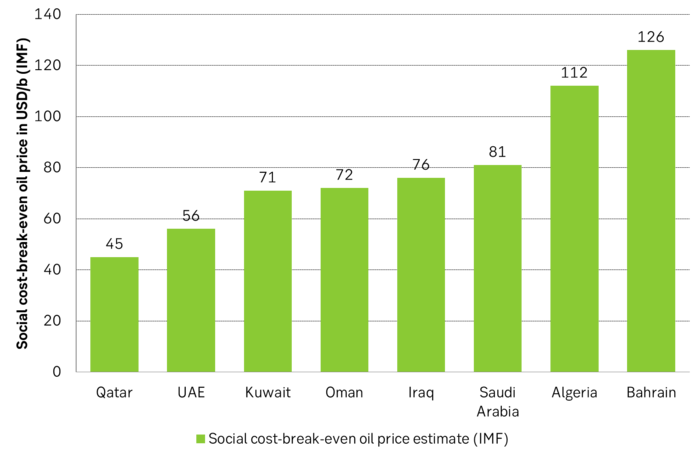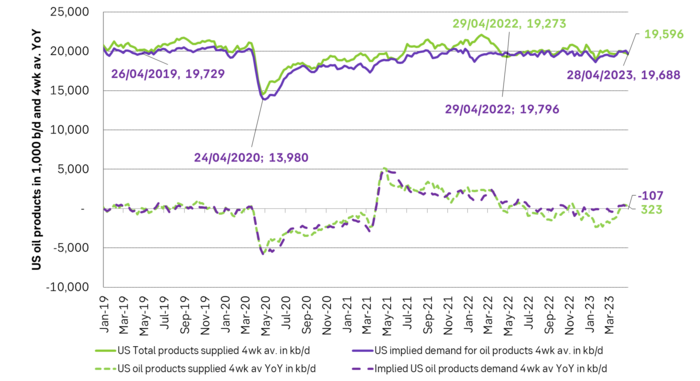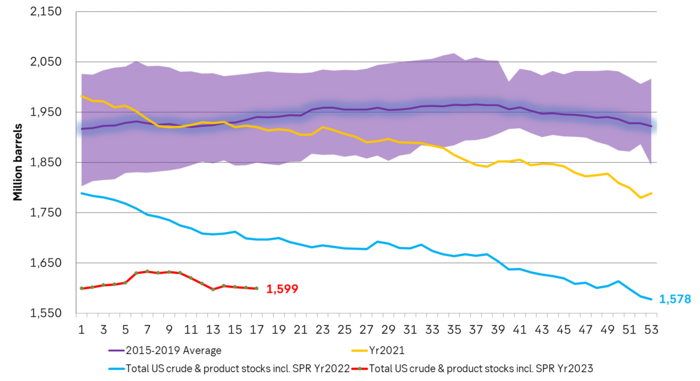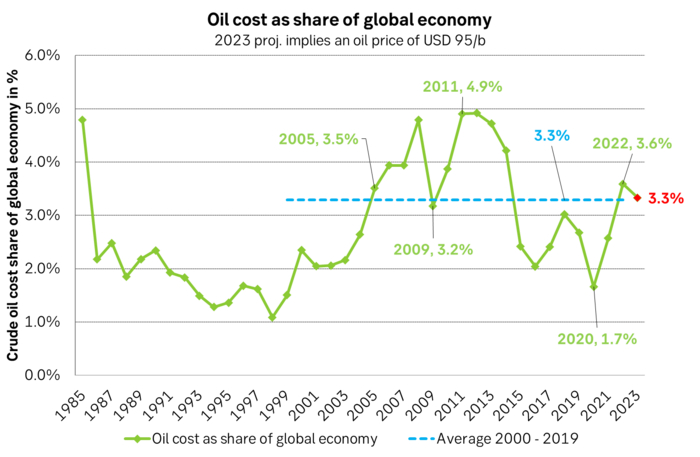Analys
A recession is no match for OPEC+

History shows that OPEC cuts work wonderfully. When OPEC acts it changes the market no matter how deep the crisis. Massive 9.7 m b/d in May 2020. Large cuts in Dec 2008. And opposite: No-cuts in 2014 crashed the price. OPEC used to be slow and re-active. Now they are fast and re-active. Latest cut indicates a ”reaction-function” with a floor price of USD 70/b. Price could move lower than that in May, but JMMC meeting on 4 June and full OPEC+ meeting on 5-6 July would then change the course. Fresh cuts now in May will likely drive market into deficit, inventory draws, stronger prices. Sell-offs in May should be a good buying opportunities

Production cuts by OPEC+ do work. They work wonderfully. Deep cuts announced by OPEC in December 2008 made the oil price bottom at USD 33.8/b on Christmas Eve. That is USD 48.3/b adj. for CPI. The oil price then collapsed in 2014 when it became increasingly clear during the autumn that OPEC would NOT defend the oil price with confirmation of no-cuts in December that year. The creation of OPEC+ in the autumn of 2016 then managed to drive the oil price higher despite booming US shale oil production. A massive 9.7 m b/d cut in production in May 2020 onward made the oil price shoot higher after the trough in April 2020.
Historical sequence pattern is first a price-trough, then cuts, then rebound. This history however points to a typical sequence of events. First we have a trough in prices. Then we get cuts by OPEC(+) and then the oil price shoots back up. This probably creates an anticipation by the market of a likewise sequence this time. I.e. that the oil price first is going to head to USD 40/b, then deep cuts by OPEC+ and then the rebound. If we get an ugly recession.
But OPEC+ is faster and much more vigilant today. Historically OPEC met every half year. Assessed the situation and made cuts or no cuts in a very reactive fashion. That always gave the market a long lead-time both in terms of a financial sell-off and a potential physical deterioration before OPEC would react.
But markets are faster today as well with new information spreading to the world almost immediately. Impact of that is both financial and physical. The financial sell-off part is easy to understand. The physical part can be a bit more intricate. Fear itself of a recession can lead to a de-stocking of the oil supply chain where everyone suddenly starts to draw down their local inventories of crude and products with no wish to buy new supplies as demand and prices may be lower down the road. This can then lead to a rapid build-up of crude stocks in the hubs and create a sense of very weak physical demand for oil even if it is still steady.
Deep trough in prices is possible but would not last long. Faster markets and faster OPEC+ action means we could still have a deep trough in prices but they would not last very long. Oil inventories previously had time to build up significantly when OPEC acted slowly. When OPEC then finally made the cuts it would take some time to reverse the inventory build-up. So prices would stay lower for longer. Rapid action by OPEC+ today means that inventories won’t have time to build up to the same degree if everything goes wrong with the economy. Thus leading to much briefer sell-offs and sharper and faster re-bounds.
OPEC+ hasn’t really even started cutting yet. Yes, we have had some cuts announced with 1.5 m b/d reduction starting now in May. But this is only bringing Saudi Arabia’s oil production back to roughly its normal level around 10 m b/d following unusually high production of 11 m b/d in Sep 2022. So OPEC+ has lots of ”dry powder” for further cuts if needed.
OPEC reaction function: ”USD 70/b is the floor”. The most recent announced production cut gave a lot of information. It was announced on 2nd of April and super-fast following the 20th of March when Dated Brent traded to an intraday low of USD 69.27/b.
JMMC on 4 June and OPEC+ meeting on 5-6 July. Will cut if needed. OPEC+ will now spend the month of May to assess the effects of the newest cuts. The Joint Ministerial Monitoring Committee (JMMC) will then meet on 4 June and make a recommendation to the group. If it becomes clear at that time that further cuts are needed then we’ll likely get verbal intervention during June in the run-up to 5-6 July and then fresh cuts if needed.
Oil man Biden wants a price floor of USD 70/b as well. The US wants to rebuild its Strategic Petroleum Reserves (SPR) which now has been drawn down to about 50%. It stated in late 2022 that it wanted to buy if the oil price fell down to USD 67 – 72/b. Reason for this price level is of course that if it falls below that then US shale oil production would/could start to decline with deteriorating energy security for the US. Latest signals from the US administration is that the rebuilding of the SPR could start in Q3-23.
A note on shale oil activity vs. oil price. The US oil rig count has been falling since early December 2022 and has been doing so during a period when the Dated Brent price has been trading around USD 80/b.
IMF estimated social cost-break-even oil price for the different Middle East countries. As long as US shale oil production is not booming there should be lots of support within OPEC+ to cut production in order to maintain the oil price above USD 70/b. Thus the ”OPEC+ reaction-function” of a USD 70/b floor price. But USD 80/b would even satisfy Saudi Arabia.

US implied demand and products delivered is holding up nicely YoY and on par with 2019. So far at least. Seen from an aggregated level.

Total US crude and product stocks including SPR. Ticking lower. Could fall faster from May onward due to fresh cuts by OPEC+ of 1.5 m b/d

An oil price of USD 95/b in 2023 would place cost of oil to the global economy at 3.3% of Global GDP which is equal to the 2000 – 2019 average.

Analys
Bombs to ”ceasefire” in hours – Brent below $70

A classic case of “buy the rumor, sell the news” played out in oil markets, as Brent crude has dropped sharply – down nearly USD 10 per barrel since yesterday evening – following Iran’s retaliatory strike on a U.S. air base in Qatar. The immediate reaction was: “That was it?” The strike followed a carefully calibrated, non-escalatory playbook, avoiding direct threats to energy infrastructure or disruption of shipping through the Strait of Hormuz – thus calming worst-case fears.

After Monday morning’s sharp spike to USD 81.4 per barrel, triggered by the U.S. bombing of Iranian nuclear facilities, oil prices drifted sideways in anticipation of a potential Iranian response. That response came with advance warning and caused limited physical damage. Early this morning, both the U.S. President and Iranian state media announced a ceasefire, effectively placing a lid on the immediate conflict risk – at least for now.
As a result, Brent crude has now fallen by a total of USD 12 from Monday’s peak, currently trading around USD 69 per barrel.
Looking beyond geopolitics, the market will now shift its focus to the upcoming OPEC+ meeting in early July. Saudi Arabia’s decision to increase output earlier this year – despite falling prices – has drawn renewed attention considering recent developments. Some suggest this was a response to U.S. pressure to offset potential Iranian supply losses.
However, consensus is that the move was driven more by internal OPEC+ dynamics. After years of curbing production to support prices, Riyadh had grown frustrated with quota-busting by several members (notably Kazakhstan). With Saudi Arabia cutting up to 2 million barrels per day – roughly 2% of global supply – returns were diminishing, and the risk of losing market share was rising. The production increase is widely seen as an effort to reassert leadership and restore discipline within the group.
That said, the FT recently stated that, the Saudis remain wary of past missteps. In 2018, Riyadh ramped up output at Trump’s request ahead of Iran sanctions, only to see prices collapse when the U.S. granted broad waivers – triggering oversupply. Officials have reportedly made it clear they don’t intend to repeat that mistake.
The recent visit by President Trump to Saudi Arabia, which included agreements on AI, defense, and nuclear cooperation, suggests a broader strategic alignment. This has fueled speculation about a quiet “pump-for-politics” deal behind recent production moves.
Looking ahead, oil prices have now retraced the entire rally sparked by the June 13 Israel–Iran escalation. This retreat provides more political and policy space for both the U.S. and Saudi Arabia. Specifically, it makes it easier for Riyadh to scale back its three recent production hikes of 411,000 barrels each, potentially returning to more moderate increases of 137,000 barrels for August and September.
In short: with no major loss of Iranian supply to the market, OPEC+ – led by Saudi Arabia – no longer needs to compensate for a disruption that hasn’t materialized, especially not to please the U.S. at the cost of its own market strategy. As the Saudis themselves have signaled, they are unlikely to repeat previous mistakes.
Conclusion: With Brent now in the high USD 60s, buying oil looks fundamentally justified. The geopolitical premium has deflated, but tensions between Israel and Iran remain unresolved – and the risk of missteps and renewed escalation still lingers. In fact, even this morning, reports have emerged of renewed missile fire despite the declared “truce.” The path forward may be calmer – but it is far from stable.
Analys
A muted price reaction. Market looks relaxed, but it is still on edge waiting for what Iran will do

Brent crossed the 80-line this morning but quickly fell back assigning limited probability for Iran choosing to close the Strait of Hormuz. Brent traded in a range of USD 70.56 – 79.04/b last week as the market fluctuated between ”Iran wants a deal” and ”US is about to attack Iran”. At the end of the week though, Donald Trump managed to convince markets (and probably also Iran) that he would make a decision within two weeks. I.e. no imminent attack. Previously when when he has talked about ”making a decision within two weeks” he has often ended up doing nothing in the end. The oil market relaxed as a result and the week ended at USD 77.01/b which is just USD 6/b above the year to date average of USD 71/b.

Brent jumped to USD 81.4/b this morning, the highest since mid-January, but then quickly fell back to a current price of USD 78.2/b which is only up 1.5% versus the close on Friday. As such the market is pricing a fairly low probability that Iran will actually close the Strait of Hormuz. Probably because it will hurt Iranian oil exports as well as the global oil market.
It was however all smoke and mirrors. Deception. The US attacked Iran on Saturday. The attack involved 125 warplanes, submarines and surface warships and 14 bunker buster bombs were dropped on Iranian nuclear sites including Fordow, Natanz and Isfahan. In response the Iranian Parliament voted in support of closing the Strait of Hormuz where some 17 mb of crude and products is transported to the global market every day plus significant volumes of LNG. This is however merely an advise to the Supreme leader Ayatollah Ali Khamenei and the Supreme National Security Council which sits with the final and actual decision.
No supply of oil is lost yet. It is about the risk of Iran closing the Strait of Hormuz or not. So far not a single drop of oil supply has been lost to the global market. The price at the moment is all about the assessed risk of loss of supply. Will Iran choose to choke of the Strait of Hormuz or not? That is the big question. It would be painful for US consumers, for Donald Trump’s voter base, for the global economy but also for Iran and its population which relies on oil exports and income from selling oil out of that Strait as well. As such it is not a no-brainer choice for Iran to close the Strait for oil exports. And looking at the il price this morning it is clear that the oil market doesn’t assign a very high probability of it happening. It is however probably well within the capability of Iran to close the Strait off with rockets, mines, air-drones and possibly sea-drones. Just look at how Ukraine has been able to control and damage the Russian Black Sea fleet.
What to do about the highly enriched uranium which has gone missing? While the US and Israel can celebrate their destruction of Iranian nuclear facilities they are also scratching their heads over what to do with the lost Iranian nuclear material. Iran had 408 kg of highly enriched uranium (IAEA). Almost weapons grade. Enough for some 10 nuclear warheads. It seems to have been transported out of Fordow before the attack this weekend.
The market is still on edge. USD 80-something/b seems sensible while we wait. The oil market reaction to this weekend’s events is very muted so far. The market is still on edge awaiting what Iran will do. Because Iran will do something. But what and when? An oil price of 80-something seems like a sensible level until something do happen.
Analys
Very relaxed at USD 75/b. Risk barometer will likely fluctuate to higher levels with Brent into the 80ies or higher coming 2-3 weeks

Brent rallied 12% last week. But closed the week below USD 75/b and it is still there. Very relaxed. Brent crude rallied 12% to USD 78.5/b in the early hours of Friday as Israel attacked Iran. The highest level since 27 January this year. The level didn’t hold and Brent closed the day at USD 74.23/b which was up 5.7% on the day and 11.7% on the week. On Friday it was still very unclear how extensive and lasting this war between Iran and Israel would be. Energy assets in Iran had still not been touched and Iran had not targeted other Middle East countries’ energy assets or US military bases in the region. As such, the Brent crude closed the week comfortably at around USD 75/b. Which one cannot argue is very much of a stressed price level.

Israel is targeting Iran’s domestic energy infrastructure. Not its energy export facilities. For now. Over the weekend Israel has widened its targets to include fuel depots in Tehran, refineries supplying Iran domestically and also a processing plant at Iran’s South Pars gas field – the world’s largest. So far it appears that Israel has refrained from hurting Iranian oil and gas export facilities. Maybe adhering to Trump’s whish of low oil prices. Trump has been begging for a lower oil price. Would be very frustrating for him if Israel started to blow up Iran’s export facilities. Focus instead looks to be on Iran’s domestic energy supply and infrastructure. To weaken and disable the operations of Iran as a country while leaving Iran’s energy export facilities intact for now at least. That is probably why Brent crude this morning is only trading at USD 74.9/b with little change from Friday. An incredible relaxed price level given what is going on in the Middle East.
Israel seems to try to do to Iran what Israel recently did to Lebanon. Israel now seems to have close to total control of the Iranian air space. So called ”Air Supremacy” something which is rarely achieved according to Phillips P. O’Brian (see comment on this below with link). This is giving Israel close to total freedom in the airspace over Iran. Israel now seems to try to do to Iran what Israel recently did to Lebanon. Take out military and political commanders. Take out the air defenses. Then grind the rest of its defensive capacities to the ground over some time.
Continuous pressure. No rest. No letting up for several weeks seems likely. The current situation is a very rare opportunity for Israel to attack Iran with full force. Hamas in Gaza, Hezbollah in Lebanon, Iranian strongholds in Syria, are all severely weakened or disabled. And now also Air Supremacy of the airspace over Iran. It is natural to assume that Israel will not let this opportunity pass. As such it will likely continue with full force over several weeks to come, at least, with Israel grinding down the rest of Iran’s defensive capabilities and domestic energy supply facilities as far as possible. Continuous pressure. No rest. No letting up.
What to do with Fordow? Will Iran jump to weapons grade uranium? The big question is of course Iran’s nuclear facilities. Natanz with 16,000 enrichment centrifuges was destroyed by Israel on Friday. It was only maximum 20 meters below ground. It was where Iran had mass enrichment to low enrichment levels. Fordow is a completely different thing. It is 500 meters deep under a mountain. It is where enrichment towards weapons grade Uranium takes place. Iran today has 408 kg of highly enriched uranium (IAEA) which can be enriched to weapons grade. It is assumed that Iran will only need 2-3 days to make 25 kg of weapons grade uranium and three weeks to make enough for 9 nuclear warheads. How Israel decides to deal with Fordow is the big question. Ground forces? Help from the US?
Also, if Iran is pushed to the end of the line, then it might decide to enrich to weapons grade which again will lead to a cascade of consequences.
Brent is extremely relaxed at USD 75/b. But at times over coming 2-3 weeks the risk barometer will likely move higher with Brent moving into the 80ies or higher. The oil price today is extremely relaxed with the whole thing. Lots of OPEC+ spare capacity allows loss of Iranian oil exports. Israeli focus on Iran’s domestic energy systems rather than on its exports facilities is also soothing the market. But at times over the coming two, three weeks the risk barometer will likely move significantly higher as it might seem like the situation in the Middle East may move out of control. So Brent into the 80ies or higher seems highly likely in the weeks to come. At times at least. And if it all falls apart, the oil price will of course move well above 100.
Phillips P. OBrien on ”Air Supremacy” (embedded link): Air power historian Philip Meilinger: ”Air Superiority is defined as being able to conduct air operations “without prohibitive interference by the opposing force.” Air Supremacy goes further, wherein the opposing air force is incapable of effective interference.”
Thus, air supremacy is an entirely different beast from air superiority. It occurs when one power basically controls the skies over an enemy, and can operate practically anywhere/time that it wants without much fear of enemy interference in its operations.
The US had Air Supremacy over Germany in the second World War, but only at the very end when it was close to over. It only had Air Superiority in the Vietnam war, but not Supremacy. During Desert Storm in 1990-1991 however it did have Supremacy with devastating consequences for the enemy. (last paragraph is a condensed summary).
-

 Analys4 veckor sedan
Analys4 veckor sedanBrent steady at $65 ahead of OPEC+ and Iran outcomes
-

 Nyheter3 veckor sedan
Nyheter3 veckor sedanUSA slår nytt produktionsrekord av naturgas
-

 Analys4 veckor sedan
Analys4 veckor sedanAll eyes on OPEC V8 and their July quota decision on Saturday
-

 Nyheter2 veckor sedan
Nyheter2 veckor sedanStor uppsida i Lappland Guldprospekterings aktie enligt analys
-

 Nyheter3 veckor sedan
Nyheter3 veckor sedanBrookfield ska bygga ett AI-datacenter på hela 750 MW i Strängnäs
-

 Nyheter3 veckor sedan
Nyheter3 veckor sedanSommaren inleds med sol och varierande elpriser
-

 Nyheter3 veckor sedan
Nyheter3 veckor sedanOPEC+ ökar oljeproduktionen trots fallande priser
-

 Nyheter2 veckor sedan
Nyheter2 veckor sedanSilverpriset släpar efter guldets utveckling, har mer uppsida









